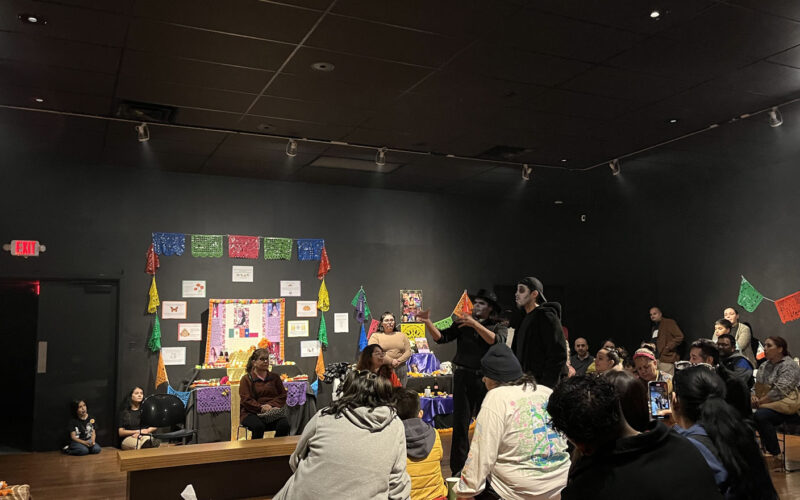April Wallace
awallace@nwaonline.com
Each year a beautiful celebration takes place in early November as people honor their lost loved ones. Día de los Muertos (Day of the Dead) is observed with costumed people in parade, in dance and by serving foods in downtown Springdale.
A block away, at the Medium, LatinX Theatre Project has for the past four years been doing a celebration of their own, Las Ofrendas: A Día de Muertos Celebration. It’s set this year for 6- 9 p.m. Nov. 2 at the Medium in Springdale.
“Ours is newer, smaller and more intimate,” said Rebecca Rivas of LatinX Theatre Project. This one is based Las Ofrendas and focuses on altars and ofrendas, offerings placed in a home altar. The group invites a variety of local artists and organizations to build altars in the black box space of the Medium. Then members of the community can come out and participate in one.
“The community altar is for folks to be able to honor their loved ones who have passed,” Rivas said.
Each year brings something new or different. During the first year of the event, Rivas said, they made tissue paper Cempasuchil, or Marigolds. Patrons came in, made the flower and wrote the name of a loved one, then placed it on the altar.
“We have different variations of that every year,” Rivas said. “It’s super important. When you’re coming, it’s for you, something that if you want to participate, you can come and just be a part of the day.”
Even if you’ve experienced the celebration before, it can feel fresh each time because this event changes. Every year, new people make the altars. LatinX Theatre Project makes one or two, and the general consensus of what you might want to celebrate also changes.
Last year one altar honored migrants who lost their lives trying to cross border to the U.S. Others were built for Latina entertainers. Local artists craft a variety of altars, such as “Toxic,” who made a beautiful painting for his grandmother, and Teen Action Support Center did one in the first year for their pets.
“You never know what someone is going to choose to honor, it can be someone they knew personally or people who have perhaps not met but feel like they want to be honored on the day,” Rivas said.
This year’s event will have six or seven total, including the community altar. It also promises activities for children, including coloring pages and a performance for kiddos. This one is “Super Torta,” which Rivas describes as a fun show.
LatinX Theatre Project creates a short, 10-15 minute play for Día de Muertos that always centers on a theme. Last year’s was on grief, but this year’s will be more of a celebration of life. A group poem, which they write together, is another recurring element.
“It’s about community sharing space on that day,” Rivas said. “I think it’s a moving event. People, when you’re remembering and celebrating, you’re welcoming those folks to be with you on that day. We build the space, but that is what’s happening.”
Some typical things that go into this event’s Día de Muertos altars include items commonly found home altars: candles, water, Cempasuchil/marigolds, pan de muerte (pastry you can get at panaderias), photos of the people you’re remembering and sugar skulls decorated with icing.
“You leave what you want them to enjoy, (knowing that) they’re enjoying in the afterlife,” Rivas said. That can vary by person, whether it’s their favorite drink, like a Coca-Cola or in the case of the migrants crossing, some of whom were children, candies.
A lot of significance is tied up in the items, she said, reasons why they include flowers, candles, papel picado, water. The day holds a lot of symbology.
Water is to hydrate and quench spirits on their journey back home. Cempasuchil also helps them find their way back, through scent. On the day, Rivas and other organizers try and make sure folks know what they’re doing and why they’re doing it, so everyone can share in the purpose.
“We try and be very intentional about how we build the evening,” she said. “To make sure it’s at once fun and beautiful.”



